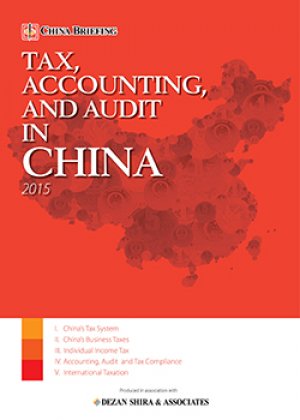China’s Fapiao System: Fapiao and Value-Added Tax
 By Steven Elsinga and Jim Qiao
By Steven Elsinga and Jim Qiao
This article is additional unpublished content from our latest issue of China Briefing Magazine, titled “Managing Your Accounting and Bookkeeping in China.” The second part of this series goes into printing fapiao.
For those new to China, the fapiao system can be an especially confusing part of domestic bookkeeping. In China, all business transactions are required by law to be recorded on an official receipt (or ‘fapiao’ in Chinese).
Fapiao differ from regular receipts in that they are printed on special paper that must be purchased from the tax authorities. If a transaction is not printed on an official fapiao, the authorities will not recognize it, and the enterprise will be unable to use the expense for tax deductions or refunds. This also means that employees must submit official fapiao to declare expenses for reimbursement from their employer.
A company may only issue a fapiao if the transaction is within that company’s business scope. For this reason, when a company first applies for a license to issue fapiao, the tax authorities will look at the company’s size and business scope to decide what kind and how many fapiao the company may legally issue.
![]() RELATED: Understanding China’s ‘Fapiao’ Invoice System
RELATED: Understanding China’s ‘Fapiao’ Invoice System
When a company is incorporated, it needs to state what activities it intends to perform on its business license, and keep its actual operations within this scope. The fapiao system is one means to enforce this requirement, as a company cannot issue fapiao for activities outside its business scope; in turn, if its customers are unable to receive fapiao, they will be unable to declare their purchases as expenses.
Fapiao and Value-added Tax
Transactions covered under China’s Value-added Tax (VAT) system need to be printed on a different type of fapiao than those that are not. Further, there are two types of VAT fapiao: Special VAT fapiao for VAT-covered transactions, issued by a General Taxpayer to another business; and regular VAT fapiao, for all other instances, including sales to consumers, VAT-covered transactions done by small scale taxpayers (more below) or sales of tax-free goods and services.
VAT in China
VAT is one of three major indirect taxes in China, the other two being business tax (BT) and consumption tax.
VAT is considered a neutral tax, allowing businesses to offset VAT incurred on relevant purchases from their own VAT liability. Conversely, BT is levied on gross turnover with no deduction permitted for tax paid on the purchase of other goods or services. The two taxes are generally not mutually deductible.
VAT taxpayers are categorized into General Taxpayers and small-scale taxpayers based on their annual taxable sales amount. Taxpayers with annual taxable sales exceeding the annual sales ceiling set for small-scale taxpayers must apply for General Taxpayer status.
![]() RELATED: General VAT Taxpayer Status: Why It’s So Critical
RELATED: General VAT Taxpayer Status: Why It’s So Critical
Small-scale taxpayers are subject to a lower uniform VAT rate of three percent (as compared to rates ranging from 6 to 17 percent for General Taxpayers) but they cannot credit input VAT from output VAT, nor are they entitled to VAT export exemptions and refunds.
Special VAT Fapiao
General Taxpayers must issue Special VAT fapiao when selling goods or services covered by VAT to customers other than consumers. These invoices need to state the sales amount and output VAT of the transaction. The buyer may then use this Special VAT fapiao to offset his or her VAT liability.
A Special VAT invoice comprises three copies, as follows:
- Bookkeeping copy – the bookkeeping voucher for the issuer;
- Deduction copy – the tax deduction voucher for the customer who made the purchase; and
- Invoice copy – the bookkeeping voucher for the customer who made the purchase.
Small-scale taxpayers cannot issue Special VAT fapiao and therefore are unable to offset their VAT paid. This is why many businesses are reluctant or unwilling to do business with companies that do not possess general taxpayer status.
For this reason, VAT payers whose annual taxable sales are below the ceiling, as well as newly established businesses, can voluntarily apply for General Taxpayer recognition. Several conditions need to be met:
- Have an estimated annual taxable turnover exceeding RMB 500,000 (for manufacturing enterprises), exceeding RMB 800,000 (for trading enterprises) or exceeding RMB 5 million (for services covered by VAT)
- Possess a fixed place of business
- Be capable of setting up legitimate, valid and accurate bookkeeping
- Meet additional soft requirements, such as office size and number of employees
Special VAT Fapiao Quota
The number of Special VAT fapiao given to a taxpayer is subject to quotas, both on the quantity of fapiao that may be printed, and the RMB amount of each individual fapiao, as determined by the company’s local tax authorities.
Generally, a newly established company starts with a quota of 25 fapiao, each with a limit of RMB 10,000. This limit applies to the individual fapiao, so for two transactions of RMB 5,000, two separate fapiao would need to be issued. In other words, one cannot add up the two transactions under a single RMB 10,000 fapiao.
If a company exhausts its supply of Special VAT fapiao, it will need to go to the tax bureau to purchase new ones. Alternately, if its sales volume in a given month exceeds the original quota, the company can apply for a temporary value increase for its fapiao.
Only after several temporary increases will a permanent value increase of be approved, and the company may have to show that it has a reached certain threshold of annual income. In comparison, it is easier to obtain a quantity increase, i.e. from 25 to 75 pieces of Special VAT fapiao.
 This article is additional unpublished content from the March-April issue of China Briefing, titled “Managing Your Accounting and Bookkeeping in China“, in which we discuss the difference between the International Financial Reporting Standards, and the accounting standards mandated by China’s Ministry of Finance. We also pay special attention to the role of foreign currency in accounting, both in remitting funds, and conversion. In an interview with Jenny Liao, Dezan Shira & Associates’ Senior Manager of Corporate Accounting Services in Shanghai, we outline some of the pros and cons of outsourcing one’s accounting function. This article is additional unpublished content from the March-April issue of China Briefing, titled “Managing Your Accounting and Bookkeeping in China“, in which we discuss the difference between the International Financial Reporting Standards, and the accounting standards mandated by China’s Ministry of Finance. We also pay special attention to the role of foreign currency in accounting, both in remitting funds, and conversion. In an interview with Jenny Liao, Dezan Shira & Associates’ Senior Manager of Corporate Accounting Services in Shanghai, we outline some of the pros and cons of outsourcing one’s accounting function. |
![]()
 Tax, Accounting, and Audit in China 2015
Tax, Accounting, and Audit in China 2015
This edition of Tax, Accounting, and Audit in China, updated for 2015, offers a comprehensive overview of the major taxes foreign investors are likely to encounter when establishing or operating a business in China, as well as other tax-relevant obligations. This concise, detailed, yet pragmatic guide is ideal for CFOs, compliance officers and heads of accounting who must navigate the complex tax and accounting landscape in China in order to effectively manage and strategically plan their China operations.
 Strategies for Repatriating Profits from China
Strategies for Repatriating Profits from China
In this issue of China Briefing, we guide you through the different channels for repatriating profits, including via intercompany expenses (i.e., charging service fees and royalties to the Chinese subsidiary) and loans. We also cover the requirements and procedures for repatriating dividends, as well as how to take advantage of lowered tax rates under double tax avoidance treaties.
 Annual Audit and Compliance in China
Annual Audit and Compliance in China
In this issue of China Briefing, we discuss annual compliance requirements for foreign-invested enterprises, including wholly-foreign owned enterprises, joint ventures and foreign-invested commercial enterprises, as well as the less demanding requirements for representative offices. We also highlight the most recent tax and legal changes that will significantly influence the way companies do business in China in 2014.
- Previous Article Passare da un ufficio di rappresentanza (Representative Office – RO) ad una Wholly Foreign Owned Enterprise – WFOE: Quali benefici fiscali?
- Next Article Buying and Printing Fapiao









